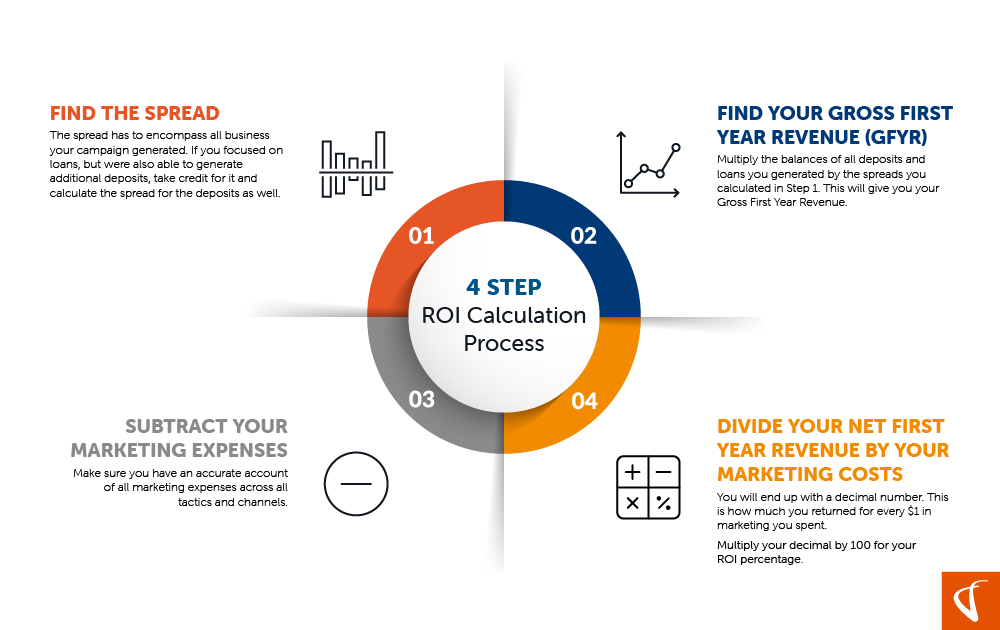
Updated 2:09 PM CST, Mon January 21, 2019
Published Under:

This is Part 3 of our 4-part series looking at the four stages of running a marketing campaign as a financial marketer. It picks up at the end of the previous post, so you will want to read Part 1: Start with Profitability, Part 2: Build a Winning Campaign Strategy, and Part 3: Nail Your Campaign Execution.
“What did we bring in for our last campaign?”
As a financial marketer, you have heard this question – THE question – before. Your executives want to know how you’re spending the money they allocated for you. You also need to prove that marketing is worth the investment.
In the Financial Brand's 2016 Financial Marketing Survey, 96% of marketing executives said measuring ROI was either a major or minor challenge; 90% of non-marketing executives said the same.
As a marketer, you need to know how to show return on investment, or ROI, of everything you do. This is especially true with campaigns.
Generating deposits and loans are where marketing can have the largest impact on the bottom line. This post will focus on just that.
ROI is more than a simple equation
The most popular equation for calculating ROI is revenue – costs divided by your costs, or:
This is the equation you will end up solving for. But first you must know what your actual revenue and costs are. It’s not as simple as “We generated $10 million in deposits, so that’s our revenue.”
You have to contend with loan portfolio yields, cost of funds rates and loan rates. What fun!
Key Terms to Know
To limit confusion about terms that are going to show up a lot in this post, let’s hit a quick vocabulary lesson.
- ROI- return on investment, shown as a percentage. For example, if your ROI for a campaign is 81%, that means for every $1 of marketing expense you generated $0.81 in return.
- Loan Portfolio Yield- also known as Weight Average Rate; we’ll abbreviate it to WAR in this post. This is the average loan rate charged to your customers with a loan at your institution. Ask your CFO or Finance Department for this number.
- Cost of Funds- the interest rate paid on funds used in day to day operations at your bank or credit union. Ask your CFO or Finance Department for this number.
- Spread- the difference between your Loan Portfolio Yield (WAR) and Cost of Funds rates. It is expressed as a percentage. When you use spread in an equation move your decimal point two places to the left. So a spread of 2.75% would be 0.0275 when used in an equation.
Key Equations to Memorize
You will also need to learn and memorize some basic equations:
Calculating the spread for deposits: WAR minus interest rate on the deposits your campaign generated = spread for deposits
- Example: If your WAR is 4.31% and your campaign generated new CD accounts with an interest rate of 2.75%, the equation would be 4.31% - 2.75% = 1.56%.
Calculating the spread for loans: WAR minus your cost of funds rate = spread for loans
- Example: If your WAR is 4.31% and your organizations cost of funds rate is 0.76%, the equation would be 4.31 – 0.76 = 3.55%.
Gross first year revenue: Your calculated spread multiplied by the balance of deposits/loans you generated; balance times spread.
- Example: Using our deposit spread from above, 1.56%, let’s say we generated $5 million worth of deposits. The equation would $5,000,000 x 0.0156 = $78,000
The 4 Step ROI Calculation Process
First, let’s define the steps of the process. Then we’ll go through it with some actual numbers for practice.
Step 1 - Find the spread.
The spread has to encompass all business your campaign generated. If you focused on loans, but were also able to generate additional deposits, take credit for it and calculate the spread for the deposits as well.
Additionally, complete the process for deposits and loans with varying rates. If you generated CDs at 2.75% and additional deposits for an account that pays 0.50%, you have to calculate separate spreads for each of those.
**There is a catch for loans. When you calculate the spread, you use the WAR of the loans you generated instead of the overall WAR for your institution.
Step 2 – Find your Gross First Year Revenue (GFYR).
Multiply the balances of all deposits and loans you generated by the spreads you calculated in Step 1. This will give you your Gross First Year Revenue.
If you have multiple types of business generated, add all the Gross First Year Revenue numbers together for your total Gross First Year Revenue.
Step 3 – Subtract your marketing expenses.
Make sure you have an accurate account of all marketing expenses across all tactics and channels.
The number remaining is your Net First Year Revenue.
Step 4 – Divide your Net First Year Revenue by your marketing costs.
You will end up with a decimal number. This is how much you returned for every $1 in marketing you spent.
Multiply your decimal by 100 for your ROI percentage.
Real World Example
Let’s walk through an example of our four-step process with some real numbers. This will be for a home equity loan campaign that also generated additional deposits.
Campaign Parameters:
- Marketing spend: $80,000
- Home equity loan promotional rate for campaign: 2.80%
- Loan portfolio yield (WAR): 4.16%
- Cost of funds- 0.79%
Campaign Results
- $4,000,000 in loans at 2.80% promotional rate
- $2,000,000 of other loads at 3.30%
- $150,000 of deposits with interest rate of 0.50%
Step 1 - Calculate the spread.
The first thing to note is that we generated business for three different products:
- Home equity loan at 2.80%
- Other loans at 3.30%
- No-interest deposit accounts
This means we will need to calculate three separate spreads.
Home Equity Spread: WAR of loans generated – cost of funds
- WAR of loans generated = 2.80%; cost of funds = 0.79%
- Equation: 2.80% - 0.79% = 2.01%
Other Loans Spread: WAR of loans generated – cost of funds
- WAR of loans generated = 3.30%; cost of funds = 0.79%
- Equation: 3.30% - 0.79% = 2.51%
Deposits Spread: WAR – interest rate paid
- WAR = 4.16%; interest rate paid = 0.50%
- Equation: 4.16% - 0.50% = 3.66%
Step 2 – Find your Gross First Year Revenue (GFYR)
This is where the balances of loans and deposits you generated come in. Don’t forget: your WAR is a percentage, so divide it by 100 before using it.
Home equity loans gross first year revenue
- $4,000,000 generated loans x 0.0201 = $84,000 GYFR
Other loans gross first year revenue
- $2,000,000 generated loans x 0.0251 = $50,200 GFYR
Deposit accounts gross first year revenue
- $150,000 generated deposits x 0.0366 = $5,490 GFYR
Add all gross first year revenue numbers together: $84,000 + $50,200 + $5,490 = $139,690 total Gross First Year Revenue.
Step 3 – Subtract your marketing expenses to get your Net First Year Revenue
Gross First Year Revenue: $139,690; marketing expenses: $80,000
Equation: $139,690 - $80,000 = $59,690 Net First Year Revenue
Step 4 – Divide your Net First Year Revenue by your marketing costs
Net First Year Revenue: $59,690; marketing expenses: $80,000
Equation: $59,690 / $80,000 = 0.746 x 100 = ROI of 74.6%
In this campaign, for every $1 in marketing we spent, we generated $0.74 in return.
You can use this process for pre-campaign ROI calculations, too!
This is a great exercise to run through different outcomes to set the right kinds of expectations with management. It can expose a marketing campaign that may perform poorly.
To complete a pre-campaign ROI calculation, you need the following:
- Your marketing expense
- Your promotional rate for the campaign, whether you’re focusing on loans or deposits
- Your loan portfolio yield (WAR) from your finance department
- Your cost of funds from your finance department
Now you can begin testing with different volumes of business generated. Don’t forget to include the possibility of additional deposits or loans outside of what you’re promoting.
If you’re seeing a low or negative ROI in your pre-campaign calculations, there are three things you can do to increase your ROI:
- If it’s a loan campaign, raise the interest rate (get together with your finance people on this one)
- Increase the volume of loans or deposits generated
- Decrease your marketing cost
Go forth and calculate! – your 4 takeaways
- Being able to report ROI makes you and your boss’s job easier. It’s also a way to show why you deserve budget and additional resources. Ultimately, it’s about being in charge of your destiny.
- Commit the equations mentioned above to memory. You’re going to be using them a lot.
- You can prevent a campaign disaster with pre-campaign ROI calculations! Running different ROI scenarios demonstrates your expertise and involves you more in defining the parameters of the campaign itself
- Befriend your finance department and CFO. You’re going to be relying on them for a lot of information. You’re also going to need them to calculate ROI on squishier marketing efforts like branding efforts and community events.
Need help with campaign strategy, execution and the other steps before ROI calculations? We can help with that!


Comments